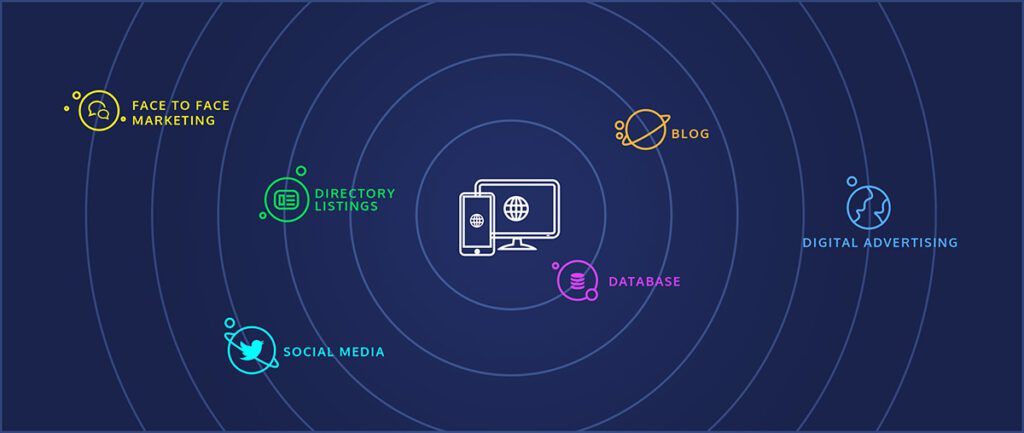Working with local small and medium sized businesses on their website builds, their branding and their advertising, there’s one thing that we hear: a sigh. That slow, audible release of heavy air, signifying frustration, confusion or a sense of overwhelm.
When does this happen? Clients sigh when we broach the topic of marketing and how they could be doing more there. Many of these clients are already overwhelmed running their businesses and just the mention of the word ‘marketing’ makes them sigh – out loud.
We get it. Marketing can be overwhelming. There’s a sense of never doing enough, of always having another social network, another ad, another event, to pull off – just to reach a few more people. But this isn’t how it has to be.
Marketing should be effortlessly built into your business model, so that you are doing it without worry and without extra stress. In order to do so, it helps if you have a visual model to ground your understanding of what you’re doing. That’s why we present to you now our concentric circle model of online marketing.

Your website: center and anchor
In our concentric circle model, your website sits smack dab in the center. Think of your website as the anchor of your online presence. And even your off-line. Well-designed, well-conceived and thoroughly SEO’d, it is your 24/7/365 salesperson. Here you control the 2D environment so that you can make a visit to this place as pleasant and compelling as possible.
Here you get your message across without interfering noise. It can be an oasis. Here you can create the experience you want your clients to enjoy. Your website does the work itself: calls to action and clearly defined navigation elements push conversion and ultimately turn visitors into clients.
Your website sits at the center of these circles – being where you drive people to in your other tactical efforts.
In the first ring is your database and your direct marketing tactic.
Compile a list of prospects, suspects, loyal customers, even influencers. Market to THEM first. You can segment this database list as likely to buy or likely to spread the word… or both. You own this list and no one can take it away from you. They are already primed to hear from you.
Use direct marketing tactics like e-newsletters, bulletins 3 dimensional physical mailers and whitepapers to create meaningful and anticipated connection with your segmented audiences. You own your mailing list, so this ring is crucial. It’s a huge asset; use it! And stay top of mind with folks.
In the next ring is your blog and content marketing material.
Your blog is a great source for reaching an audience beyond your direct contact list. Target certain keywords in your blogs so that people find you on search. Create blogs that answer questions that people actually pose. Be the source for information and become the expert that people come to depend on. Use your blogs as social media fodder and get people back to your website, where more of a story can be told.
Next comes local directory listings
Directory listings like on your Google My Business page or your Yelp page are vital properties that direct people to you. Depending on your industry, these may be the most visited pages of all! They should be accurate, up-to-date and search-optimized to project your mission and uniqueness. And they should point to your website! These listings help you get ranked on Google and add to your ‘authority’ – so seek out lots of them that are relevant.
The next circle is your social media properties.
Social media is a powerful tactic in online marketing. Your Facebook page, your Instagram account, your LinkedIn business page – these platforms position you for prominence. When you post on these platforms, you can bring people BACK to the website, where you do the more detailed job of selling.
But despite the power of these platforms to gain broad reach, you are ultimately at the mercy of the Zuckerberg’s and Bezo’s of the world! They are platforms that you do not control; you’re basically ‘renting’ the empty lot on Pinterest or Amazon. The ‘landlords’ of these properties can change the rules in an instant. That’s why these tactics are on the periphery of the circles here – you are working from the website out prioritizing tactics that you own and drive.
Next is your paid advertising: banner ads, PPC, retargeting.
Paid advertising is a great way to reach a more extended audience and to help spread the word about your business. Well placed ads—including banners on popular sites, and retargeting for people who have demonstrated interest by visiting your site at least once, can significantly increase traffic. But remember: if people are not directed eventually to your website, then the ad dollars are just ‘bread on the water’. Your website is what really sells them on your product or service. Use ads to always send them THERE.
Last circle: face to face or what we call ‘3D Marketing’.
Our concentric circles even touch the offline world – to face to face interaction. When you meet someone at a networking event, where do you send them to learn more about your business? Send them to the website. They should be able to get all the information they need and sign up for a newsletter, say, right there. By keeping your website front and center, you keep the lines of marketing clear and make sure that everyone knows where to find your business presented in its best 2D form.
Though connecting people to see your page on Facebook or LinkedIn is smart, it should always be secondary to encouraging the person you met at the gala banquet, back to your highly informative website. The website is the core of ALL marketing efforts.
Our concentric circle marking approach is not new, but can vastly simplify how you understand your marketing efforts and keep you focused on the prize of conversions and increased sales. In putting your website at the center of your marketing efforts, you might want to take a second look at how effective it is in attracting and converting visitors. If that’s the case, consider a web audit with One Tribe Creative, or talk to us about our monthly Key Performance Indicator (KPI) meetings to track your progress and diagnose any issues with your site.
